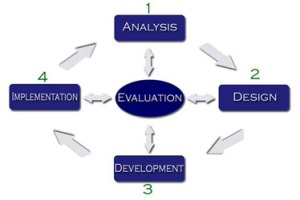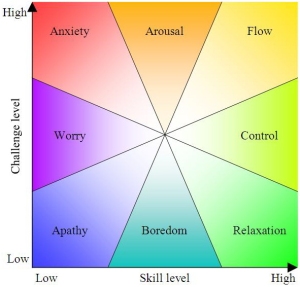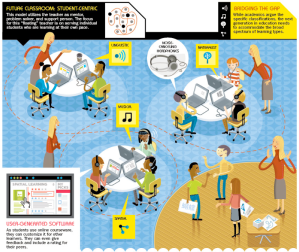Comprehensive Reflection
A comprehensive reflection referring to my entire experience as a Master’s student of Educational Technology.
What’s Love Got to Do with It?
Ask anyone who loves to read why they love it and you’ll get varying answers but the process of learning to read is a passion reserved for linguists. They exist, but are a rare breed. To me, Educational Technology is a language. I love that I have become literate in this language, though I could never be to EDTEC what Shakespeare is to English, but my passions lay with the humanities. I love studying history, literature, philosophy, art, and rhetoric, but these are time-consuming hobbies that require a certain patience that only a rare middle school student possesses. Before one can enjoy history and the arts, one must learn to learn.
To me, educational technology, like reading, is a language art, a way of approaching the process of learning. Through the EDTEC discipline, I have learned how to be a better instructional designer of humanities in the hopes that I can invoke the same passions for the humanities in my students. If I fail to inspire within my students a passion for the discipline of humanities, then with the implementation of technology in my classroom, I will at least assist students with the acquisition of the digital language required to succeed in American society today. Learning to speak “digitally,” has become invaluable to me because my students, most of whom have not yet developed the critical thinking skills required for the discipline of humanities, are inadvertently developing tools for learning what they will need for their future success regardless of self-interests–literacy in both reading and technology.
EDTEC has helped me to reach my students and demonstrate the relevance of the least appreciated discipline of the American public school system and for that, I am grateful. But, endeavoring to accomplish a Master of Arts degree in EDTEC has been one of the most challenging experiences I have ever endured. The coursework has required time sacrifices from my family, my friends, my ability to tackle the everyday chores that keep my household functioning, traveling, and yes, even my job. While my heart is monogamously bound to the arts and humanities, I have acquired many valuable instructional design tools. I find these three to be my most frequently used:
- The development and implementation stages of ADDIE
- Social Learning aspects of Web 2.0 tools
- Gagne’s Nine Events of Instruction and Clark et. al. principles in Efficiency in Learning
Using principles such as Gagne’s Nine Events of Instruction and Clark et. al. efficiency in learning principles, I have revolutionized the structure of my class and how I implement learning activities. I get to the point quicker and my students retain more. I have modernized so many of my lessons from paper handouts to be digitally accessible both in school and remotely through the use of Web 2.0 tools. For instance, I used edublogs.org to upload educational videos and podcasts, then linked them to a site that I developed so students can access these tools independently from remote locations. I have used sites.google.com to develop engaging simulations, webquests, and learning activities for students to participate in remotely and collaboratively. If it wasn’t obvious enough, the ADDIE principle of development comes into play with every new tool I learn. In addition, I have had the ability to implement many of these tools in my humanities class and have evaluated throughout the process to revise and perfect my instructional design. In summary, the discipline of Educational Technology has helped me evolve from a middle school teacher to a true instructional designer. As a result, I think I am a more dynamic humanities teacher.
Ideas Shine Through
Being a student in educational technology has made me a better instructional designer for two reasons:
- I have learned some fabulous instructional tools through Web 2.0 tools
- I combine the new tools with various learning efficiency theories that I’ve studied in EDTEC.
The model that I use most frequently in my own instructional design is Gagne’s Nine Events of Instruction which I studied in EDTEC 572, Technology for Course Delivery. The nine events are:
 What I love about Gagne’s Nine Events is that they make learning precise and concise. It is because of Gagne’s Nine Events that I most likely developed an affinity for Clark, Nguyen, and Sweller’s Efficiency in Learning: Evidence-Based Guidelines to Manage Congnitive Load.
What I love about Gagne’s Nine Events is that they make learning precise and concise. It is because of Gagne’s Nine Events that I most likely developed an affinity for Clark, Nguyen, and Sweller’s Efficiency in Learning: Evidence-Based Guidelines to Manage Congnitive Load.
I read Efficiency in Learning: Evidence-Based Guidelines to Manage Cognitive Load cover to cover for EDTEC 795A, Seminar, and acquainted myself with its principles. Cognitive load theory, the basis for efficiency in learning, is a “universal set of learning principles that are prove to result in efficient instructional environments” (Clark et. al. 2006). Since we live in a world of information overload, cognitive load theory is extremely valuable. There are three types of cognitive load:
- Intrinsic: the thinking by the learner trying to process complex content
- Germane: the learners’ thinking about an activity they must perform
- Extraneous: the thinking that is unrelated to the goal for the learner
Reducing extraneous cognitive load was the theme of Clark et. al. and helped me to grow as an instructor. I think this is particularly valuable, for instance, when designing a job aid. One way to reduce cognitive load in a job aid is to provide a diagram of whatever is being learned. For instance, if one is learning about excel, an image of a spreadsheet with steps written below it can be overload. The text can be reduced to captions that are placed in the appropriate part of a diagram to increase learning efficiency. By reducing the cognitive load, the learner will be less frustrated (Clark et. al. 2006).
Reducing learner frustration leads to Mihaly Csikszentmihalyi’s (Pronounced “Chicks send me high” according to the Professor) theory, Conditions of Flow, which we studied in EDTEC 670, Games and Simulations. Flow is defined as the mental state to be in for optimal learning to take place. Flow can be identified by the learner being:
- Completely involved, focused, concentrating – with this either due to innate curiosity or as the result of training
- Sense of ecstasy – of being outside everyday reality
- Great inner clarity – knowing what needs to be done and how well it is going
- Knowing the activity is doable – that the skills are adequate, and neither anxious or bored
- Sense of serenity – no worries about self, feeling of growing beyond the boundaries of ego – afterwards feeling of transcending ego in ways not thought possible
- Timeliness – thoroughly focused on present, don’t notice time passing
- Intrinsic motivation – whatever produces “flow” becomes its own reward (Farmer 1999)
I really loved this theory about learning because it gives me a sense of what state of mind to put learners in while I am the instructor. It also, for better or worse, puts me in a place of judgment of my instructor when I am the learner.
The only negative side of EDTEC is that my expectations from my own instructors has increased as I realize that maintaining learner engagement is not just an art, but also a science.
Change
Just one week prior to completing this portfolio, I attended a four day summer institute at USD (University of San Diego) called “Leading Schools in a Flat World: Globalization and Its Implications for Education.” I was one of the only teachers attending this workshop as most others were administrators. The theme of the institute was that despite the expectations of NCLB (No Child Left Behind) in terms of student performance on standardized tests in language arts and mathematics, it is the duty of teachers to assist students in developing their passions and to prepare students for the 21st century global economy. According the video, “Shift Happens,” China’s and India’s students who perform in the top 20th percentile in math will outnumber the United States’ total population of students. With this future trajectory, we need to focus on more than just test scores for our students. In addition, standards of living in these countries will most likely continue be far below those of the United States which means engineers in our country will continue to lose jobs to Asians who can work for seven times less money.
This doesn’t mean that one shouldn’t become an engineer, if that is the passion of an American student, but it does mean that our nation needs to look beyond math scores for this Net Generation’s future economic prosperity. To give some hope to this trajectory, the truth is nothing has changed since the 1960s in terms of our test scores relative to China’s. Yet, despite our deficiency in math scores, we have continued to prosper economically, and currently hold more patents than any other country in the world (Zhao 2009).
While I remain an instructor of 7th grade social studies (World History and Geography: Medieval to Early Modern Times), with my new “flat world, Net Gen” mindset, I intend to use my core content as a tool to help my students develop the 21st century skills that they truly need. My objectives are daunting yet doable–here is the list of tools/skills that I intend to integrate in my classroom:
- Set up/use a Gmail account
- Enroll into Moodle (introduce concept of distance learning)
- Set up or use Twitter account – follow me through text message (if students have a cell phone)
- Set up iGoogle page
- Use Google docs
- Learn effective Power point design
- Advanced skills in Word
- Demonstrate electronic file system
- Develop digital portfolios / web pages
- Show students how to purchase a domain name
- Conference via Skype with classmates here and overseas
- Blogs (writing tools/etiquette)
- Wikis
- Podcast
- Video production
- Other numerous Web 2.0 tools
- PBL (Project-Based Learning)
- Other online collaboration tools
Through the use of job aids, process mapping, and the psychology of instructional design, especially the efficient learning principles I discussed such as Gagne’s Nine Events of Instruction, cognitive load theory, and conditions for flow, I will incorporate technology integration into my social studies/art class. One of the primary changes in my thinking that resulted from my studies in Educational Technology is that it is essential for teachers to trains students for the global economy of the 21st century. While our students are digital natives, they are not necessarily digitally literate. Students still need to be familiar with proper writing conventions and online etiquette. Our students need to be critical thinkers, they will also need to collaborate both in person and online. The tools I listed above are just some of the many valuable ones I learned as an EDTEC student that I intend to pass on to my students.
One of the greatest “A-Ha’s” I had during this program, however, is the need to apply digital tools through a core content area. I was so much more engaged when I was learning tools while designing and developing a project for implementation in my social studies classroom. The artifacts I produced that related to social studies consumed me and I was motivated to learn the technology when I was operating in the context of my passion. The students of the future need technology tools, but they also need to develop their passions. If technology is not one of their passions, then they need to discover what is and learn digital tools through that passion. For technology integration to be effectively applied in a classroom, teachers need to develop TPCK: Technological Pedgogical Content Knowledge (Liebke 2008). Alas, while the future for me is open and bright, another endeavor I intend to pursue is taking a lead in the shifting of teacher PD (professional development) for technology integration from being tool-based to being content-based. I think secondary/single subject teachers (grades 6-12) will more willingly embark in technology integration if they learn implementation strategies that differ from grades K-5. I would like to see technology integration consistently in K-8 classes and then more advanced technology classes offered to high school students. I would like to be part of the PD or even someday be a college/university instructor in a history class that meets both in person and online. I envision classrooms of the future replicating the one seen above. Though the learning was tedious and challenging, I am excited to embark on the new world that has opened up to me through Educational Technology.
References
Clark, R., Nguyen, F., Sweller, J. (2006). Efficiency in Learning: Evidence-Based Guidelines to Manage Cognitive Load. Pfeiffer: San Francisco, CA.
Farmer, David. 1999. “Flow and Mihaly Csikszentmihalyi.”
Gagnè, R. (1985). The Conditions of Learning and the Theory of Instruction, (4th ed.), New York: Holt, Rinehart, and Winston.
Spathas, Matthew T. (2009).”Light Speed 09 (ppt).” http://www.ibrary.com/about/index.htm
The Performance Juxtaposition Site. “Robert Gagne’s Nine Steps of Instruction.” http://www.skagitwatershed.org/~donclark/index.html.
Wikipedia. “Mihaly Csikszentmihalyi.” Retrieved from the World Wide Web on July 14, 2009 at: http://en.wikipedia.org/wiki/File:Challenge_vs_skill.jpg
Zhao, Yong. (2009). “What Knowledge is of Most Worth in the 21st Century (ppt).” College of Education: Michigan State Universtiy.

